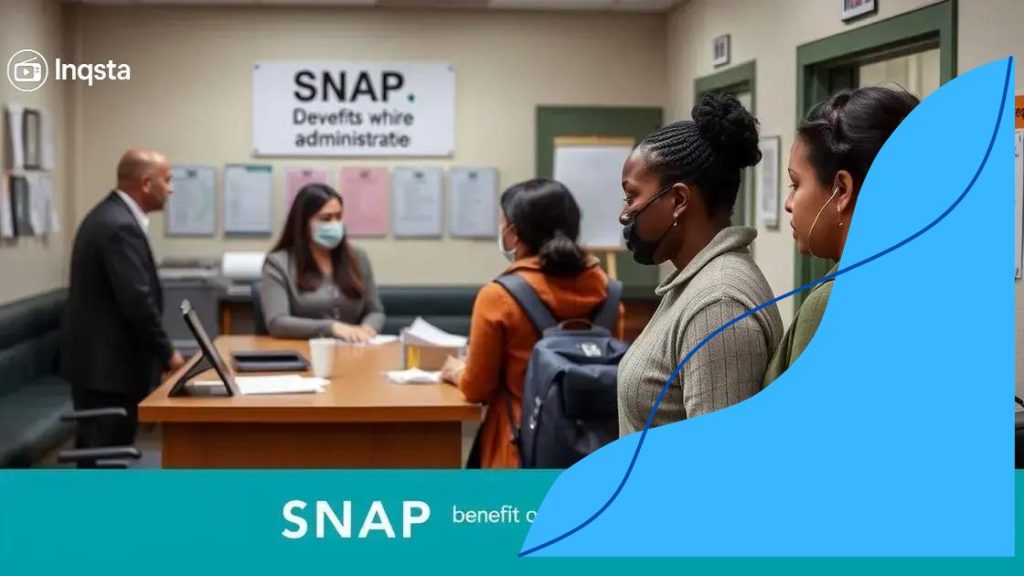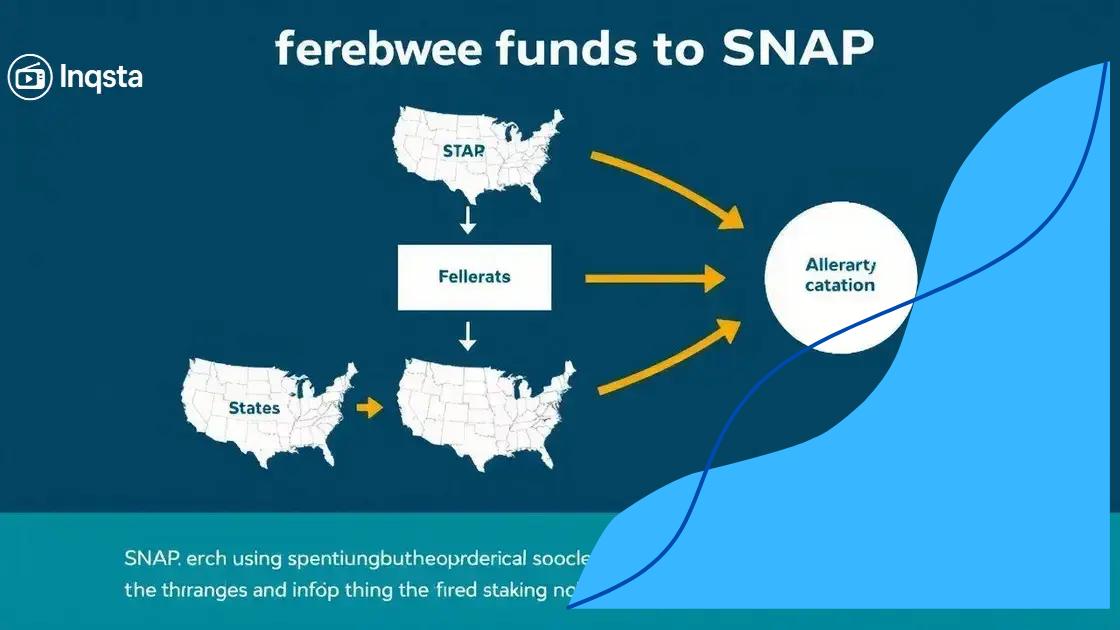SNAP lawful use of federal funds: what you need to know

Anúncios
Ensuring lawful use of SNAP funds involves adhering to guidelines that restrict purchases to eligible food items, reporting income changes, and protecting personal account information to maintain program integrity.
SNAP lawful use federal funds is crucial for maintaining the integrity of government assistance programs. But do you really know how these funds are utilized? In this article, we’ll dive deep into the structure of SNAP funding and its impact on eligible recipients.
Anúncios
Understanding SNAP and its federal funding
Understanding the SNAP program and its federal funding is essential for anyone needing assistance. SNAP, or the Supplemental Nutrition Assistance Program, is designed to provide food support to those who qualify. By understanding how the funding works, recipients can better navigate the system.
What is SNAP?
SNAP helps millions of Americans afford nutritious food. The program is vital for families, seniors, and individuals facing economic hardships. It’s important to know that federal funds make this support possible.
How is Federal Funding Allocated?
Funding for SNAP comes from the federal government and is distributed to states. Each state manages its own SNAP program, tailoring it to local needs while following federal guidelines. The amount allocated depends on factors like state population and economic conditions.
Anúncios
- Distribution is based on state needs
- Adjustments occur during economic shifts
- Funds are monitored for lawful use
States have the responsibility to ensure proper usage of these funds. This includes verifying eligibility and avoiding misuse. Proper management maintains the program’s integrity, ensuring it continues to serve those in need.
Impact on Local Communities
By understanding SNAP’s federal funding, communities can better support its local implementation. When funds are used effectively, they uplift families and help reduce hunger. Engaging with local SNAP offices can provide more information on available resources.
Eligibility criteria for SNAP benefits
Eligibility criteria for SNAP benefits are vital for understanding who can receive assistance. To qualify for this crucial support, applicants must meet specific requirements. These criteria ensure that those who truly need help can access the resources available.
Basic Eligibility Requirements
To be eligible for SNAP, applicants must generally meet the following conditions:
- Must be a U.S. citizen or legal resident
- Must meet state residency requirements
- Must demonstrate financial need based on household income
Furthermore, households can include family members or single individuals. Each state’s rules might have slight variations, but the core requirements often remain the same. Understanding the definition of income is also essential.
Income and Resource Limits
SNAP benefits are determined partially by household income and resources. Each household’s total income is compared against the federal poverty level. Generally, households must have a gross monthly income below a specific limit, which varies by state. Resources like bank accounts are also considered.
- Households with limited resources qualify for a higher benefit
- Certain assets, such as a home and retirement accounts, may not count
- States may allow deductions for specific living expenses
In addition to income limits, other factors include household size and expenses. Understanding the nuances helps potential recipients navigate the process smoothly. Knowing if you qualify can be the first step towards gaining access to necessary nutritional support.
How federal funds are allocated in SNAP

Understanding how federal funds are allocated in the SNAP program is crucial for grasping the program’s impact. These funds come from the federal budget and are designed to help low-income families access nutritious food. With this funding, SNAP ensures that assistance reaches those in need across the country.
Distribution of Funds
Federal SNAP funds are distributed to each state based on a variety of factors. These include the number of eligible individuals in the state and local economic conditions. Each state’s share can change yearly, adapting to shifts in need.
- Funding allocations are impacted by state population
- Economic downturns often lead to increased funding
- State agencies determine local distribution
This system allows each state to respond quickly to the needs of its residents. States use the funds to provide direct assistance to households, covering a variety of food expenses. This direct support is vital for families to access essential nutrition.
Managing and Monitoring Funds
Proper management of these funds is necessary to prevent fraud and mismanagement. States establish processes to ensure that funds are utilized correctly. Regular audits and evaluations help maintain transparency and accountability.
- States are tasked with compliance and oversight
- Monitoring ensures funds are used lawfully
- Reports are generated to track the use of funds
Understanding how federal funds flow into SNAP helps recipients appreciate the program’s structure. This transparency can also encourage eligible individuals to apply for benefits, knowing there is a systematic process in place to ensure they receive the help they need.
Common misuses of SNAP funding
Understanding the common misuses of SNAP funding is critical to maintaining the program’s integrity. Misuse can lead to penalties for recipients and impact the overall success of the program. By identifying these issues, both the government and the community can work together to prevent them.
Types of Misuse
There are various ways in which SNAP benefits can be misused. Misleading practices often involve individuals trying to take advantage of the system.
- Using benefits for non-eligible items, like alcohol or tobacco
- Transferring benefits to someone who does not qualify
- Failing to report changes in income or household size
These actions not only harm the integrity of SNAP but can also lead to investigations and potential legal consequences. It’s essential for recipients to understand what is allowed and what is not.
Impact of Misuse
The misuse of SNAP funding has broader implications. When funds are misallocated, fewer resources are available for those who truly need assistance. This can lead to food insecurity for vulnerable families. Government agencies invest considerable resources into monitoring and correcting misuse, which can divert attention from providing support to eligible recipients.
- Increased scrutiny can lead to fewer people wanting to apply for benefits
- Trust in the program may decline among the public
- The effectiveness of SNAP could be undermined, impacting community well-being
Recognizing the impact of these misuses is key to fostering a community that supports one another and encourages lawful use of SNAP benefits. Staying informed can help individuals play their part in protecting the program’s integrity.
Ensuring lawful use of SNAP funds
Ensuring lawful use of SNAP funds is crucial to maintaining the program’s integrity and effectiveness. The federal government and state agencies work diligently to protect these funds from misuse. By understanding the rules and regulations, both recipients and agencies can ensure that the assistance provided reaches those who truly need it.
Key Practices for Lawful Use
It is important for SNAP recipients to know the best practices for lawful use of their benefits. Following guidelines helps prevent unintended misuse.
- Always use benefits for eligible food items
- Report any changes in income or household composition
- Keep personal information secure to avoid fraud
Adhering to these practices ensures that individuals maximize their benefits while protecting the integrity of the program. States also implement various strategies to support compliance among recipients.
Monitoring and Compliance Measures
State agencies conduct regular audits to monitor SNAP funds. These audits help ensure that funds are used appropriately and that recipients comply with program requirements. Agencies often utilize technology for tracking and managing benefits effectively.
- Use of Electronic Benefit Transfer (EBT) systems for tracking spending
- Training for staff on fraud detection techniques
- Community outreach to educate recipients on the rules
By fostering awareness and understanding, states can prevent misuse while empowering recipients. Keeping an open line of communication also helps establish trust between agencies and the community.
FAQ – Frequently Asked Questions about SNAP Funds
What are SNAP funds used for?
SNAP funds are primarily used to purchase eligible food items that provide nutrition to low-income families.
Who is eligible for SNAP benefits?
Eligibility for SNAP benefits generally includes U.S. citizens or legal residents who meet income and resource limits.
How can I ensure I am using SNAP funds lawfully?
To use SNAP funds lawfully, only buy approved food items, report any income changes, and keep your account information secure.
What happens if SNAP funds are misused?
Misuse of SNAP funds can lead to penalties including disqualification from the program and potential legal action.